Abstract
(1) Background: The Quaternary river bank deposits of the European North of Russia contain several mollusk fossils that can give important past-climate information which is relevant to understand the evolution of climate in the Holocene period and predict future scenarios on climate change. (2) The purpose of the research: reconstruction of the main physical and chemical parameters of the habitat of mollusks based on the determination of the species of mollusks and the study of the isotope-geochemical composition of shells and their host deposits. (3) Object of study: Quaternary deposits of coastal outcrops of the rivers of the European North of Russia: Pechora Sula, Peza, bivalve shells, and their fragments. (4) Results: The revealed macrofauna complexes represented by bivalves (Arctica islandica, Hiatella arctica, Mytilus edulis, Tridonta borealis, Mya truncata, Neptunea despecta) were determined and the variations of δ13C and δ18O (‰) isotopes in the studied fossil bivalve shells were calculated. The data on the concentrations of chemical elements in fossil shells were determined and summarized. The content of elements in mollusk shells varied within the following limits: Fe 101.7−403.3 µg/g (Vastyansky Kon’, river Pechora), Mg 0.38–2.61 µg/g (Vastyansky Kon’, river Pechora), Ba 18.27–60.44 µg/g (village Oksino-River Sula), and Sr 1128.3–2275.34 µg/g (Vastyansky Kon’-village Oksino, river Pechora). The ratio between the elements varies within Ba/Sr 0.011–0.041 (village Oksino- River Sula) and Mg/Fe 0.01–0.15 (Vastyansky Kon’- village Oksino, river Pechora).
1. Introduction
1.1. Paleogeography
Geological events that have taken place over the past 10 thousand years in the Arctic have attracted the attention of scientists from all over the world due to their crucial role in the global climate system [1,2,3]. The most important problem, which is still far from being solved, is the reconstruction of climate change, and the ocean level in the Holocene [4,5,6,7].
The reconstruction of general climatic variations is possible by restoring the physicochemical parameters of the environment in certain local areas of the Arctic, in a given period of the Holocene, with a further generalization of the obtained material. The most convenient objects for the reconstruction of paleogeographic events are the shells of bivalve mollusks, which record physicochemical signals, the benchmarks of changes in paleoenvironments in the Holocene [8,9]. In combination with fossil mollusks, sediment facies are the most important objects of study in paleogeographic reconstruction. The associated study of these objects will make it possible to recreate, with a high degree of accuracy, the paleogeographic situation in the study areas, and later, as a result of summarizing the data obtained for these areas, to reconstruct the overall picture of changes in the paleogeographic conditions in the territory during the Holocene. The reconstruction of fluctuations of physical and chemical environmental parameters in the Holocene, within certain areas in the Arctic, will make it possible to answer some of the debated arguments on the topic of the Arctic Holocene, as well as to make certain forecasts for climate change in the future.
At the beginning of the Late Pleistocene, a period that dates back 70 to 130 ka, cold climatic conditions were replaced by warmer interglacial conditions of the Mikulino(?) age, corresponding to Marine isotope stage (MIS) 5; the warmest stage is MIS 5e in the period from 130 to 117 thousand years ago. It is estimated that seawater temperatures during January were 4–8 °C warmer than at present. During this period, an extensive marine (Mikulin) transgression dominated the territory. The boreal sea engulfed the Malozemelskaya tundra (MZT). In the Pechora lowland, deposits of the Mikulin transgression are widely represented in the middle reaches of the river Sula, where they occur at altitudes of 40 to 50 m above sea level on the Zaal moraine (till) [5]. Mikulin deposits are marked by the bivalve mollusks Arctica islandica, Cerastoderma edule, and Zirphaea crispata. The Mikulin interglacial was replaced by the Early Valdai (Sartan) ice sheet in the period from 115 to 75 thousand years ago. Usually, the “Early Valdai glaciation”, understood as the Tver glaciation, which occurred from 71 to 57 thousand years ago, is correlated with MIS 4. At the beginning of this stage, there was some lightening of oxygen isotopic composition, which is probably associated with the formation of a glacier. In the period 50 to 23 thousand years ago, the Early Valdai cryochron replaced the Karginsky-Middle Valdai thermochron, which corresponds to MIS 3. Throughout the entire MIS 3 stage, Novaya Zemlya, and other areas of the Arctic and Subarctic, were ice-free in most of the Barents Sea region; and, as a result of extensive transgression, marine regime sedimentation occurred. During most of the Karginsky age, natural conditions and climate were similar to modern ones. In the time interval from 24 to 20 ka, the period of the MIS 2 climate minimum began. The level of the Barents Sea, about 17 thousand years ago, reached the lowest levels, up to 100 m. In the Early Dryas, Belling, and Middle Dryas, the period from 14 to 9 thousand years ago, temperatures rose. There was an alternation of warm phases when summer temperatures exceeded modern and cold ones. The sea level was rising. The Preboreal period, from 11 to 9.3 ka, the Boreal in the period from 9.3 to 8 ka and the Atlantic in the period from 8 to 4.6 ka, were times of a relatively even warmer climate, corresponding to the arrival of solar radiation that was 7% more modern. The Subboreal, the period from 4.6 to 2.6 ka, and the Subatlantic, the period from 2.6 ka to the present, were times of heat reduction, which corresponds to a decrease in solar radiation. A series of significant cooling events was observed with amplitudes of up to 3 °C at 55–65° N., which were separated by a climate warming of 0.5–1.5 °C warmer than the present [1,5,6]. From the east, the territory of the Arkhangelsk Region and the Nenets Autonomous Okrug is bounded by the Ural Range [10].
1.2. Geomorphology
Between the Timan Ridge and the Ural Range is the Pechora Lowland. Its northern part includes the MZT and Bolshezemelskaya tundra (BZT). The MZT is slightly undulating, and the BZT is a hilly plain, cut through by a dense river network, with hills and ridges [11,12], and its territory is enclosed by the river Pechora and Usa from the west and south, respectively, and the Polar Urals by the Pai-Khoi ridge from the east [13,14]. The natural zones and subzones of the BZT are represented by the southern shrub tundra, and to a lesser extent by the typical southern and northern forest-tundra and the northern part of the extreme northern taiga. The tundra zone occupies more than 40% of the area. The subzones of typical and southern shrub tundra are unevenly developed;southern shrub tundra accounts for more than 75%, typicallyless than 25% of the area of the entire tundra zone. Of the total area of the BZT, about 15% is the northern forest-tundra and 17% is the southern one [15,16]. The soils of the MZT are predominantly gley and peat-gley. Coastal lowland plains are included in the moss-lichen subzone of the tundra. On the loamy substrate, there are birch forests and willow forests with moss litter. Large areas are occupied by hilly-hummocky bogs. In the residual areas of mountain structures, bedrocks are covered with eluvial deposits, on which soils of light mechanical composition are formed [17]. MZT starts from the left bank of the river Pechora. The southern border is made up of the rivers Tsilma and Pyoza. The Pechora River has a length of 1809 km and a basin area of 322,000 km2 [10]. There are depressions in the delta part of the river Pechora, and in the south of the MZT in the valley of the river. The rivers Oma, Sheaf, Pyosha, Volonga, Velikaya, Indiga, and Velta flow directly into the sea. Varshinsky Viska and Urduga are tributaries of the river Peza. Peza is a tributary of the Mezen. Kosma and Tatbysh are tributaries of the Tsilma. Sula and Tsilma are tributaries of the Pechora. Soima is a tributary of the Sula [18,19,20,21,22,23,24,25,26]. Surface soils in the northern part of the MZT consist of sands with underlying post-Pliocene clays or bedrocks [27]. Sandy tundra is less common than clayey tundra [28,29]. Peatlands occur over a significant area in the treeless part of the tundra, on the northern border of continuous forests, and in lairs, as well as near the shores of lakes and rivers [30]. There are alluvial soils in the lower reaches of the Pechora River that are strongly acidic, with a low thickness of humus [31]. The coastal tundra is a mixed type, as hilly areas are found along with swampy small-hummocky areas. According to glacialists, the BZT is a vast hilly plain with a glacial relief [5,6,27]. In the opinion of marine patinters, traces of transgression are widely (but not ubiquitously) found in the BZT [32,33]. The sea, having engulfed the outskirts of the tundra, spread south along the river valleys. This circumstance is due to the existence of spaces composed of Quaternary marine sands with the remains of mollusk shells, which are now subjected to river erosion and eolian influence.
Pre-Quaternary and Quaternary deposits take part in the geological structure of the region. There are sediments of marine origin. The chemical composition of coarse-grained sediments, silts, and clays, which were once saturated with salty sea water, influences the formation of the present-day composition of lake waters in the region [34]. Loose Quaternary sediments are represented by deposits of the Middle and Late Pleistocene age—marine, river, lacustrine, eluvial, and colluvial accumulations [35,36,37,38,39]. Quaternary deposits are diverse both in origin and lithological composition, and their thickness increases to the north [40]. In the north, Holocene and Upper Pleistocene marine deposits occur. The deposits of the Middle and Upper Pleistocene are represented by dense sandy silts with inclusions of gravel, pebbles, and boulders [41]. Outcrops of clays and loams are widespread on the territory of the Pechora Lowland [42]. Quaternary deposits of the BZT and MZT have a thickness exceeding 100 m. The pre-Quaternary basement is overlain by either boulders or sands and clays with pebbles and marine fauna up to 20 m thick. These deposits, called the Pechora horizon, are considered sediments of transgressive facies of the sea that flooded the territory of the BZT at the beginning of the Middle Pleistocene. Upward, these deposits gradually pass into a thick sequence represented by dark grey loams and clays with gravel, pebbles, and boulders, containing thin members of layered and banded clays, silts, and sands of subordinate significance. There are small plant remains and shells of mollusks. Their distribution is very wide, from the Timan Ridge to the Polar Urals. On the Pechora River, an analogue of the Mezen marine layers with subarctic fauna are the sub-morainic sands of the river upper Kui and Marhida. In the area of the BZT, the marine Neopleistocene occurs up to 66°N. On the left tributaries of the Pechora and Sula, the team of glacialists obtained an age estimate for the coastal-marine sequence with boreal mollusks: −119 ± 2 ka. The thicknesses on the left bank of the Pechora, south of the river Sula, overlain by marine sediments with boreal fauna, can be attributed to the Middle Pleistocene age [43,44].
The buried Kolvin suite of marine silts with subarctic fauna and diamictons belongs to the Lower Neopleistocene. In the Upper Neopleistocene, the main markers are interglacial marine sediments, with a rich fauna of boreal transgression mollusks (Sula horizon). The latter are overlain by glacial and water-glacial deposits. A series of uranium-thorium and OSL dates of the order of 140–100 thousand years, taking into account the scatter of values characteristic of these methods, is close to the estimates of the age of the Eem interglacial [45]. South of the Markhida, at altitudes of about 100 m, glacial deposits of the Upper Pleistocene age are replaced by lacustrine-glacial formations of the large near-glacial paleo lake Komi. The OSL dates of the beach sands of Lake Komi showed an average value of 82 ± 1.2 ka [46,47]. In the river basin Mezen, a scheme was developed with four glacial stages in the first half of the Late Pleistocene [48]. The Pechora till and deposits genetically related to it were discovered by numerous boreholes in the lower Pechora, in the basins of the rivers Lai and Kolva [5]. The thickness of the Pechora till in the region does not exceed 6 m. To the south, it also increases on the river Pechora from 10 to 20 m, and sometimes up to 40 m. A characteristic feature of the Pechora till is the predominance of sedimentary and metamorphic formations (of polar Uralic-Paikhoi origin?) and the constant presence of single fragments of pink marble-like crinoid-bryozoan limestones, the leading Novaya Zemlya rocks [6]. However, studies show that the last glaciation on the shores of the Kara Sea was limited [49]. The Sulina horizon is composed of coastal-marine, alluvial, and lacustrine sediments. The formation of the Sulina deposits occurred due to the erosion of the Vychegda till.
2. Materials and Methods
2.1. Sampling Locations
Our studies were aimed at attempting to reconstruct the natural conditions that existed in the Pechora paleobasin (Figure 1) during the climatic optimums of the Pleistocene and Holocene. This may make it possible to analyze the dynamics of climate and landscape changes over time and predict changes in the natural environment in the future [50]. The names of sampling localities are given relative to nearby settlements. Fossil shells were taken at five localities (Table 1). Mikulin deposits are marked by bivalve mollusks Arctica islandica (Figure 2).
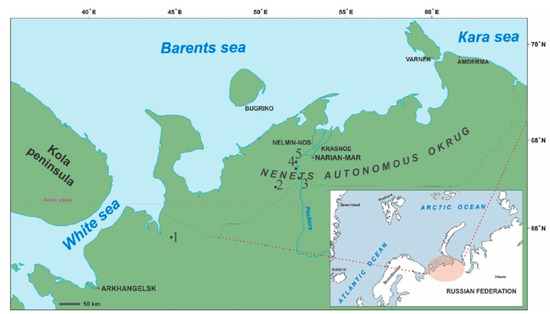
Figure 1.
Sites for sampling mollusk shells in the European North of Russia. 1: river Peza (vicinities of the village of Bychye), 2: river Sula (near the village of Kotkino), 3: Vastyansky Kon’ (river Pechora), 4: Khongurei (river Pechora), 5: location 10 km north-west of the village Oksino, river Pechora.

Table 1.
Locality and River basin of fossil shells of the European North.
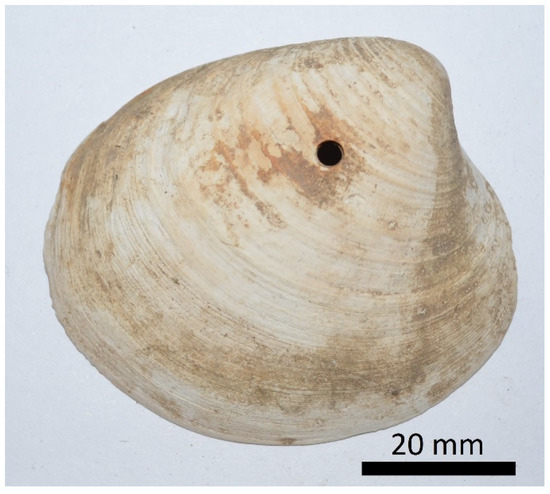
Figure 2.
The subfossil shell of the marine mollusk Arctica islandica from the Sula outcrop.
Shells from five sampling sites located in different parts of the Pechora paleobasin were used to analyze trace elements’ composition.
In July 2020, mollusk shells were sampled from coastal outcrops of the river Pechora (Vastyansky Kon’). On 3 July 2020, on the right bank of the river Pechora, mollusk shells were found in the southernmost part of the Vastyansky Kon’. Mollusk shells are confined to grey clays, which are covered with sand from above. On 4 July 2020, the location of mollusk shells was also found in the central part of the Vastyansky Kon’ outcrop (Figure 2 and Figure 3). The shells were confined to the lower part of the section (1 terrace) 1 m from the water’s edge of the Pechora River in argillaceous deposits, with interlayers of sand and rounded pebbles. On 5 July 2020 in the vicinity of the village Khongurei, in an outcrop on the left bank of the river Pechora, mollusk shells were found (Figure 4 and Figure 6, Table 1). Mostly ferruginous sands are represented in the lower part with moraine. Some of the shells were found on a moraine beach. On 5 July 2020 10 km northwest of the village Oksino, for the first-time, mollusk shells were found in outcrops of the left bank of the Pechora River (Figure 6). The shells are confined to grey clays, which are overlain by sand and peat (Table 1). In June 2017 and July 2021, about 300 samples of mollusk shells were collected from coastal outcrops of the river Peza in the vicinity of Bychye (according to Table 1, Figure 5 and Figure 6). In July 2016, 100 mollusk shells were sampled on the Sula River in the vicinity of Kotkino in MZT (according to Figure 5 and Figure 6).

Figure 3.
The structure of the outcrop Vastyansky Kon’ reproduced with permission from [3]. (a) photo of the Vastyansky Kon’ outcrop and the place where whole shells of mollusks were collected near the level of the river Pechora in gray clays (white arrow). (b) geological structure of the outcrop Vastyansky Kon’: 1: pre-Quaternary rocks; 2: pebble sands at the base of Quaternary deposits; 3–5: thickness of gray clays; 3: lower pack, 4: top pack, 5: marking layer, shell rock; 6–7: a pack of sands: 6: with sea shells, 7: continental; 8: layer of gravel-pebble loam with boulders, 9: numbers of blocks of the allochthonous thrust limb.
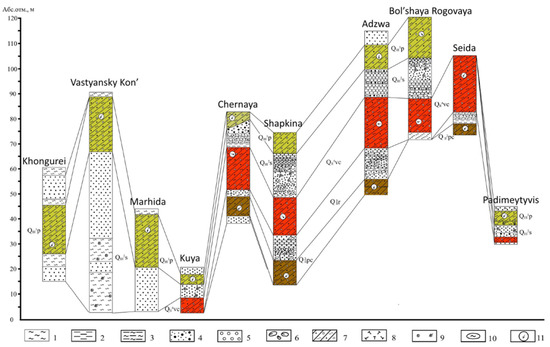
Figure 4.
Correlation of Neopleistocene deposits in the north of the Bolshezemelskaya tundra reproduced with permission from [39]. 1: clay; 2: aleurite; 3: clayey silt; 4: sand with gravel; 5: pebbles; 6: boulders; 7: moraine; 8: peat; 9: shells and shell fragments of mollusks, foraminifera; 10: clay pellets; 11: orientation of elongated rock fragments in the moraine.
2.2. Selection of Mollusk Shells
The selection of mollusk shells during the fieldwork consisted of clearing sediments in coastal localities, description of sediments, and continuous sampling of macrofauna and flora throughout the section [51]. Before the collection of fossil material, its position in the rock and relative to each other along the strike (over the area) and along the section was recorded [52]. The shells of Arctica islandica served as the material for determining the elemental composition. Arctic species have also been found, such as Macoma calcarea, Hiatella arctica, Portlandia arctica, Yoldiella lenticula, Yoldia hyperborean, Propeamussium groenlandicum, and Cerastoderma ciliatum. Details of the shell structure were studied using an Axio Lab.A1 light microscope (Carl Zeiss, Jena, Germany) and a Leica M165C stereomicroscope (Leica Microsystems, Wetzlar, Germany). Shells were sawn from the umbo to the ventral margin perpendicularly to the winter lines and along the axis of minimum growth with a diamond saw, and the obtained fragment of 10 mm width was taken for trace element analysis.
2.3. Determination of δ13C and δ18O in Mollusk Shells
Isotope determinations were carried out at the Geological Institute of the Siberian Branch of the Russian Academy of Sciences on a Finningan MAT253 mass spectrometer. Measurements of the isotopic composition of carbon and oxygen in shells were performed in the form of CO2 in the continuous helium flow mode, using a gasbench-mass spectrometer configuration. To calculate δ13C and δ18O, international standards NBS-18 and NBS-19 were used. The correctness of the obtained values was controlled by regular measurements of the Russian standards MSA-7, MSA-8, and “Grebeshok” (FEGI FEB RAS). The reproducibility of the obtained values was at the level of ±0.2‰.
2.4. Analysis of the Elemental Composition of Shells
To analyze the main and trace elements, parts of the shells were washed with MilliQ water, dried, and ground in an agate mortar. Acid dissolution of crushed shells was carried out by treating them in Merck ultrapure H2O2, Aldrich HNO3 bidistilled HNO3 + HCl, and finally in HNO3 at 80 °C in Savillex Teflon containers placed in separate evaporation chambers (class A 100), which were located inside a clean room (class ISO A 10000). This made it possible to dissolve only the carbonate and organic parts of shells without leaching impurities of silicate minerals. Along with the samples, we also processed two certified carbonate standards (Coral JCp-1, Giant Clam JCt-1). The leachate was evaporated to dryness, redissolved in 10% HNO3, and diluted 5000-fold for major and trace element analysis using an Agilent 7500ce inductively coupled plasma mass spectrometer (Agilent Technologies, Inc., Santa Clara, CA, USA) [8,53].
2.5. Statistical Treatment of the Data
Element concentrations in samples were compared using the nonparametric Mann–Whitney U and Kruskal–Wallace H tests because the data were not distributed normally (Shapiro–Wilk test). Statistical data processing was performed using StatSoft, Inc. (2011), STATISTICA (data analysis software system), version 10.
3. Results and Discussion
Bivalves are an informative fossil material that is present in a subfossil form in marine sediments. Malacofauna is a subtle indicator that relatively quickly and accurately captures and reflects changes in individual abiotic parameters of the paleogeographic setting. The study of fossil shells, and their enclosing deposits, as paleomarkers characterizing the conditions of sedimentation in the Pechora paleobasin will supplement the existing theoretical ideas about the development of the territory at the stage of climatic optimums of the Late Quaternary period. According to our hypothesis, the elemental composition and variations in the stable d18O and d13C isotopes of fossil shells will be consistent with previously established global climate fluctuations in certain periods of the Pleistocene and Holocene. To date, the correlation of Pleistocene and Holocene deposits of the Pechora paleobasin exists. The reference sections Vastyanskiy Kon’ (Figure 3), Khongurei (Figure 4 and Figure 5), Pyoza area (Bychye) (Figure 6), and Sula (Figure 7) were studied and described [54,55,56,57]. The lower marine part of the Vastyansky Kon’ outcrop is a clay strata. Dark grey, sandy clay-siltstones and clays, in some places layered, in places with lenses of grey medium-grained sand with gravel and pebbles, emerge above the water’s edge. Here, in the lower part of the outcrop of the Vastyansky Kon’, shells of mollusks are found. From about 7 m above the water’s edge, the clays become more uniform, and sometimes layering is visible, expressed due to interlayers of more silty material. At a height of 24 to 26 m, interlayers of sand with pebbles and shells appear in the clayey strata. The overlying clay sequence is also characterized by faunistic remains; a clear ferruginous contact separates it from the sands. The middle part of the Vastyansky Kon’ section is represented by a sequence of alluvial sands, the lowest part of which is a regressive marine member. Shells of boreal mollusks were previously found in it. In [58], an attempt was made to create a high-quality 3D outcrop model using a drone. The thickness of the sands has an extremely uneven thickness—from 15 to 55 m and more [39] (Figure 6).
With their foundations, clay blocks go under the river edge Pechora, and their sharp peaks rise above it to a height of 20 to 50 m [3]. Sand packs in the outcrop Vastyansky Kon’ were dated: 24,790 ± 500, 26,800 ± 3 70, 28,380 ± 270, 28,675 ± 300, and 29,470 ± 450 years old (Figure 3b, geological structure). However, the results of these radiocarbon analyses are older, because samples from peatlands were taken after the Novaya Zemlya explosions [59].
Comprehensive studies of moraine horizons in coastal outcrops made it possible to correlate them in the extreme northeast of the European Subarctic of Russia [39] (according to Figure 2).
The identified three horizons of moraines differ in lithological features. Reliable and regionally consistent lithological correlatives are the orientation of elongated rock fragments and the presence of guide boulders [39].
In the Pechora Lowland, sediments of the Late Pleistocene boreal sea include outcrops of marine sediments at the base of the sections Vastyansky Kon’, Khongurey, in a series of sections in the valley of the river Sula [54,55,56,60] (according to Figure 2, Figure 3 and Figure 4, Figure 6 and Figure 7). In all these points, only one relief-forming moraine occurs above the marine deposits. Its late Valdai age was proved not only by a series of radiocarbon dates obtained for the deposits, but also by the results of kinetostratigraphic studies [3].
The macrofauna of the lower part of the Rodionovo deposits in the Vastyansky Kon’ section includes arctic species such as Macoma calcarea, Hiatella arctica, typical arctic species Portlandia arctica, Yoldiella lenticula, Yoldia hyperborean, Propeamussium groenlandicum, and Cerastoderma ciliatum.
The presence of the boreal gastropods Buccinum undatum indicates that sedimentation took place in a shallow basin and the water temperature was higher than at present. No macrofauna was found in the upper, sandy part. In the section “Vastyansky Kon’”, marine sediments are represented by dark clays with shells, which are underlain by gravels with abundant Sulina marine fauna. In the same deposits, shells of mollusks Cyprina islandica L. and Mactra elliptica Brown were found, which also indicate the Mikulinsky (Sulinsky) age of the deposits that include them [9]. The marine clays (f), uncovered under the Vastyansky Kon’ section, are conditionally assigned to marine Chirva formations. One of the latest works devoted to the outcrop is the work [61], in which the authors carried out surface mapping and 3D photogravimetry of the outcrop.
In the Khongurei outcrop (Figure 4 and Figure 7), the sediments of the Mikulinsky horizon are exposed at the very bottom of the coastal cliff, composing the visible lower part of the Pleistocene section. The Mikulinsky horizon, up to 15 m thick here, is represented by dark grey clayey silts and black clays containing rare thin layers of grey silts with a massive and straight layered texture. Alluvial deposits of the Karginsky age are exposed in the Khongurei outcrop. They have the same structural positions and are just as glaciotectonically disturbed as the single-facies sediments of the Vastyansky Kon’. These deposits, resting on the Mikulinsky silty-argillaceous sediments, reach a maximum thickness of 20 to 25 m. Among the deposits, there are interlayers of horizontally layered silts, and very occasionally, layers of dark grey clays. In the Khongurei outcrop, boulder loams of the upper moraine scale are overlain by a member (from 1.5 to 2 m) of Late Glacial black band clays. In the north of the Pechora Lowland, alluvium is covered everywhere by the moraine of the Novaya Zemlya glacier of the last glaciation: Shapkin 1–4 stratotype sections—a series of 10 dates from 46,570 ± 1610 years ago. N. up to 36,080 ± 1780 years ago, as well as sections of the Kipievo ≥ 50,510 years ago, the Khongurei 45,170 ± 1290 years ago, and the Golodnaya Bay 44,090 ± 1160 years ago [62]. The age of glacial deposits was established as a polar Uralian on the grounds that the underlying sands in the Khongurei section, dated by the OSL method, showed an age of 45 to 63 thousand years [37].
During previous studies, a large number of fossil organic datings were done, which made it possible to clarify the time ranges of interglacial stages and the boundaries of sea transgressions in the Late Quaternary [1,3,48,58,63,64,65,66,67,68,69,70]. A lot of work has been done to reconstruct the paleoclimatic conditions for the formation of sediments during the interglacial epochs of this period [45]. However, the fossil mollusk shells found in these sections remained unanalysed by modern isotope-geochemical studies. In our opinion, the isotope-geochemical information contained in their valves can confirm and supplement the already existing climatic and landscape paleo-reconstructions of Late Quaternary interglacials. In addition, the isotope-geochemical correlation of the Pleistocene-Holocene deposits in the region under consideration is relevant, due to the preparation of a new version of the general stratigraphic scheme of Quaternary deposits.
The boreal (Mikulinsky) transgression is characterized by warm fauna. Fluvial deposits are 13–15 thousand years old and marine Mikulin deposits are older than 110 thousand years [71].
Sediments from the lower part of the Bychye section enter the marine environment with a calm hydrodynamic regime. The upper part of the section is characterized by the conditions of river floodplains and sea sands in the area of weak wave processing [66,67]. Using the electron paramagnetic resonance method for mollusk shells from a depth of 10–11 m, ages were obtained from 80 ± 8 ka to 90 ± 8 ka [72]. Sea shells occur from 5 to 15.4 m.

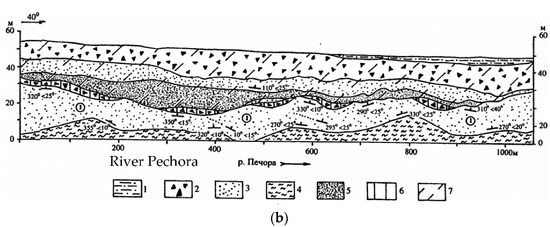
Figure 5.
Scheme of the Khongurei outcrop structure reproduced with permission from [62]. (a) Khongurei outcrop and the site of collection of fragments of mollusk shells (blue arrow). (b) Geological structure of the Khongurei outcrop: 1: late glacial banded clays of the Ostashkov glaciation; 2: boulder loams of the Ostashkov glaciation; 3: predominantly sandy sediments; 4: clayey silts of Mikulin age; 5: glaciodislocated Mikulin clays; 6–7: Ostashkovskaya scaly moraine; 6: lower scales; 7: upper scales. I: Karginsky alluvial deposits.
A comprehensive detailed study of marine sediments (lithology, microfauna, isotopic composition of benthic foraminiferal carbonates, palynology) overlying the Zaalian (Moscow) moraine in the Bychye section allow for reconstructing the history of changes in the paleoenvironment during the time of the Eemian (boreal) transgression against the background of shallowing caused by the removal of glacial load. Age determinations are based on the change of palynozones, associated with previously identified regional subdivisions. The age of the deposits was tentatively determined at 133–119.5 kyr BP [69,70]. In the marine sections of the river Peza, five ecozones are distinguished, covering the Moscow Late Glacial (zone 1) and the entire Mikulin interglacial (zones 2–5). In the section Bychye on the river Peza, all five ecozones are represented, as well as six pollen zones of the Mikulin interglacial [68]
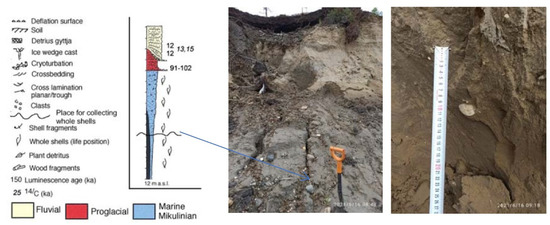
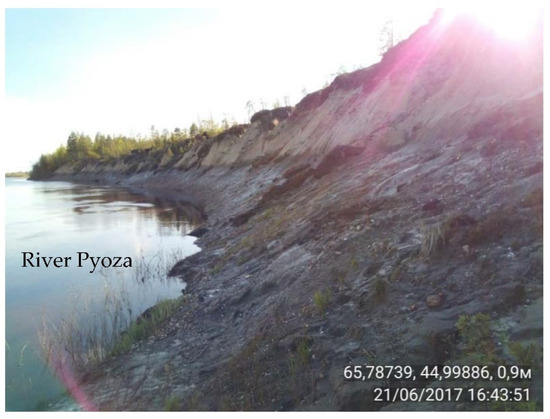
Figure 6.
Lithological logs, lower Pyoza area (Bychye). Stratigraphic logs indicate thickness, lithology, structures, glaciodynamic properties, palaeocurrent patterns, fossils, and OSL and 14C ages. The elevation in metres above present sea level of the base of each section (in most cases, the elevation of the Pyoza River bed) is indicated beneath each log. Regional stratigraphic units are identified by different colours and environmental interpretations and chronostratigraphic affiliation of units are indicated [71]. Curved pattern revealing mollusk shells.
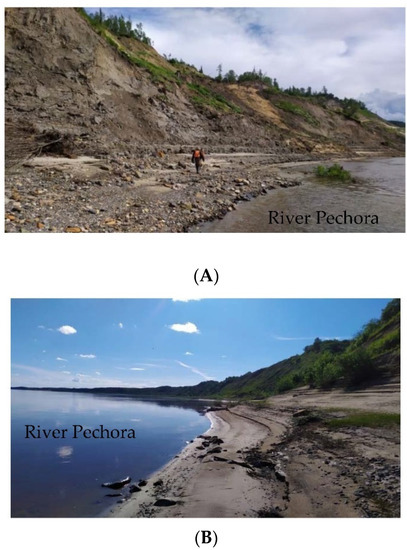
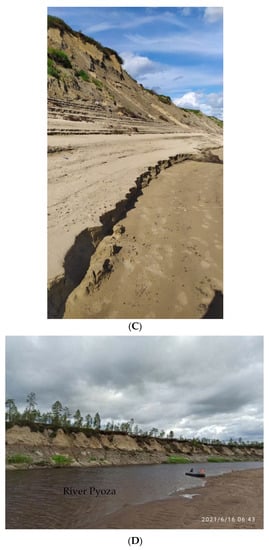
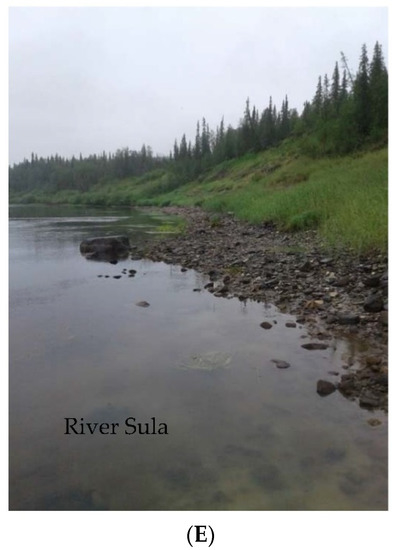
Figure 7.
Mollusk shells were collected from the following outcrops: (A): Vastyansky Kon’, (B): Khongurei, (C): 10 km northwest of the village Oksino on the river Pechora, (D): Bychye on the Peza River, (E): Sula River.
Table 2 and Figure 8 show the measurements of stable isotopes δ13C and δ18O in carbonate shells of mollusks. The data show that the ratio of these stable isotopes allows them to be divided by location according to the groups—Vastyansky Kon’, Sula River, and Peza River.

Table 2.
Variations in δ13C and δ18O isotopes in the studied fossil shells (average isotopic measurements in 5 shells) of the European North (‰).
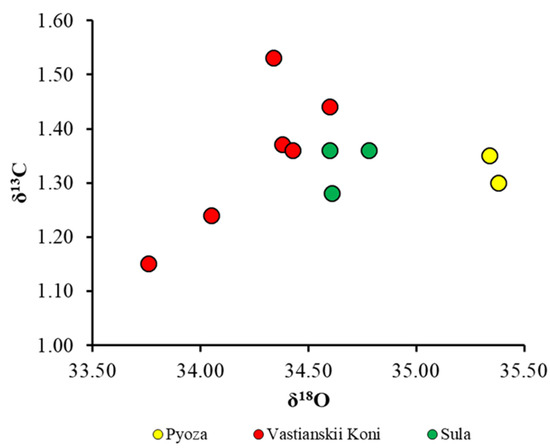
Figure 8.
Relationship between δ13C and δ18O in the studied fossil shells in the sections Peza, Vastyansky Kon’, Sula.
The content of most significant elements in of Arctica islandica, varied within the following limits: Fe 101.7–403.3 µg/g (Vastyansky Kon’), Mg 0.38–2.61 µg/g (Vastyansky Kon’), Ba 18.27–60.44 µg/g (village Oksino- River Sula), Sr 1128.3–2275.34 µg/g (Vastyansky Kon’- village Oksino). Additional information about the environmental conditions of biotopes can be obtained via the concentration ratios of an element to Ca or Fe (i.e., Mn/Fe, Ba/Sr). The ratio between the elements varies within Ba/Sr 0.011–0.041 (village Oksino-River Sula), Mg/Fe 0.013–0.1495 (Vastyansky Kon’-village Oksino) (Table 3).

Table 3.
Elemental composition (µg/g) of Arctica islandica shells from the Pechora river paleobasins (river Sula, Vastyansky Kon’, Peza).
We revealed here that there are regression relationship between temperature of ancient marine basin and level of dissolved oxygen in their waters. Therefore, a logical conclusion consisted in existence of suitable environment for marine mussels during periods with high concentrations of oxygen (reconstructed using Mn/Fe-ratio) and relatively low temperature of marine water (reconstructed using Ba/Sr-ratio) [73] (Figure 9). As shown in [74], there is a correlation between the ratio of manganese and iron concentrations in lake bottom sediments and the oxygen content in water. Therefore, the Mn/Fe ratio in fossil bivalve shells is an indicator of bottom water oxygenation (Figure 8). Furthermore, the relationship between the ratio of manganese to iron and the oxygen content in water was considered earlier in the interpretation of geochemical data [73].

Figure 9.
Relationship between Mn/Fe (oxygen) and Ba/Sr (temperature).
4. Conclusions
The content of elements in mollusk shells varied within the following limits: Fe 101.7–403.3 µg/g (Vastyansky Kon’, river Pechora), Mg 0.38–2.61 µg/g (Vastyansky Kon’, river Pechora), Ba 18.27–60.44 µg/g (village Oksino-River Sula), and Sr 1128.3–2275.34 µg/g (Vastyansky Kon’-village Oksino, river Pechora). The ratio between the elements varies within Ba/Sr 0.011–0.041 (village Oksino- River Sula) and Mg/Fe 0.01–0.15 (Vastyansky Kon’- village Oksino, river Pechora).
Analyses of the chemical composition of mollusk shells from the rivers European North of Russia—Pechora Sula, Peza—demonstrated a sizable accumulation of a small number of elements (Na, Mg, Al, Mn, Fe, Ba) in the shells. The differences in element concentrations in shells and ecosystem compartments between river basins partially stem from the lithological composition of the catchment area and the presence of bogs at the watershed.
The specificity of lithological and mineralogical composition of bottom sediments controls the conditions of chemical element distribution between the components of the riverine ecosystem in each locality. These results suggest that element accumulation in the shell depends on specific conditions of the biotope.
We revealed here that there is a regression relationship between temperature of the ancient marine basin and level of dissolved oxygen in their waters. We assume the existence of a suitable environment for mussels during periods of high oxygen concentration (can be reconstructed from the Mn/Fe ratio) and relatively low seawater temperature (can be reconstructed from the Ba/Sr ratio). There is a known relationship between the ratio of manganese and iron concentrations in bottom sediments and the oxygen content in water. Therefore, we used the Mn/Fe ratio in fossil bivalve shells as an indicator of bottom water oxygenation and favorable conditions for their existence during this period.
Author Contributions
Conceptualization, S.I. and A.L.; methodology, S.I. and A.L.; software, A.L.; validation, A.L.; formal analysis, A.L.; investigation, S.I.; resources, E.Y.; data curation, E.Y.; writing—original draft preparation, S.I.; writing—review and editing, S.I. and A.L.; visualization, S.I.; supervision, E.Y.; project administration, E.Y.; funding acquisition, E.Y. All authors have read and agreed to the published version of the manuscript.
Funding
The research was accomplished due to financial support provided by the Russian Scientific Fund Grant No. 20–77–10057, “The diagnostics of permafrost degradation based on isotope tracers (234U/238U, δ18O+δ2H, δ13C+14C)”, a project supervised by E. Yu. Yakovlev, Candidate of Geological and Mineralogical Sciences.
Institutional Review Board Statement
Not applicable.
Informed Consent Statement
Not applicable.
Data Availability Statement
Not applicable.
Acknowledgments
We express our thanks to Vidas V. Kriauciunas for all his help in collecting malacofauna.
Conflicts of Interest
The authors declare no conflict of interests.
References
- Väliranta, M.; Kaakinen, A.; Kuhry, P. Holocene climate and landscape evolution East of the Pechora Delta, East-European Russian Arctic. Quat. Res. 2003, 59, 335–344. [Google Scholar] [CrossRef]
- Arslanov, K.A.; Berdovskaya, G.N.; Loseva, E.I.; Filonov, B.A. New data on continental Mikulinsky deposits in the Lower Pechora. Bull. Leningr. State Univ. 1975, 24, 139–142. [Google Scholar]
- Lavrov, A.S.; Potapenko, L.M. Neopleistocene of the Northeast of the Russian Plain; Aerogeology: Moscow, Russia, 2005; 222p. [Google Scholar]
- Pokrovsky, O.S.; Shirokova, L.S.; Viers, J.; Gordeev, V.V.; Shevchenko, V.P.; Chupakov, A.V.; Vorobieva, T.Y.; Candaudap, F.; Causserand, C.; Lanzanova, A.; et al. Fate of colloids during estuarine mixing in the Arctic. Ocean. Sci. 2014, 10, 107–125. [Google Scholar] [CrossRef] [Green Version]
- Astakhov, V.I.; Svensen, J.I. Cover formation of the final pleistocene in the extreme north-east of European Russia. Reg. Geol. Metallog. 2011, 47, 12–27. [Google Scholar]
- Andreicheva, L.N.; Sudakova, N.G. Reliability assessment of interregional correlation of middle Neopleistocene glacial horizons in the center and north of the Russian plain. Izv. Komi Sci. Cent. Ural Branch Russ. Acad. Sci. 2014, 2, 55–67. [Google Scholar]
- Gray, J. Evolution of the freshwater ecosystem: The fossil record. Palaeogeogr. Palaeoclimatol. Palaeoecol. 1988, 62, 1–214. [Google Scholar] [CrossRef]
- Bolotov, I.N.; Pokrovsky, O.S.; Auda, Y.; Bespalaya, J.V.; Vikhrev, I.V.; Gofarov, M.Y.; Lyubas, A.A.; Viers, J.; Zouiten, C. Trace element composition of freshwater pearl mussels Margaritifera spp. across Eurasia: Testing the effect of species and geographic location. Chem. Geol. 2015, 402, 125–139. [Google Scholar] [CrossRef]
- Vostrukhina, T.M.; Ilyinova, A.A. Biostratigraphy of the Vastyansky Kon’ section on the river. Pechora. In Palynology of the Pleistocene and Pliocene; Nauka: Moscow, Russia, 1973; p. 39. [Google Scholar]
- Fedorov, D.F. Atlas of the Arkhangelsk Region; GUGK: Moscow, Russia, 1976; p. 72. [Google Scholar]
- Loseva, E.I.; Duryagina, D.A. Late Pleistocene Lacustrine Sediments in the Center of the Malozemelskaya Tundra (Soima River Basin). Geology and Minerals of the North-East of the European Part of the USSR. Yearbook; IG Komi Academy of Sciences of the USSR: Syktyvkar, Russia, 1976; pp. 54–61. [Google Scholar]
- Rusanova, G.V. Bolshezemelskaya tundra: A look into the past. Sci. Russ. 2007, 1, 12. [Google Scholar]
- Lukin, A.A.; Dauvalter, V.A.; Novoselov, A.P. Ecosystem of the Pechora River in Modern Conditions; Publishing House of the KSC RAS: Apatity, Russia, 2000; 192p. [Google Scholar]
- Nikolskaya, O.A. Late Pleistocene History of the Hydrographic Network of the Northern Part of the Pechora Basin; Abstract of the Thesis of a Candidate of Geological and Mineralogical Sciences: Saint Petersburg, Russia, 2006; 19p. [Google Scholar]
- Goryachkin, S.V. Soil Cover of the North; TEOS: Moscow, Russia, 2010; 414p. [Google Scholar]
- Simvalova, S.E.; Zarkhidze, V.S. Legend of the Pechora Series of Sheets of the State Geological Map of the Russian Federation M 1:200,000: Explanatory Note, 2nd ed.; All-Russian Research Geological Institute named after A.P.Karpinsky: Ukhta, Russia, 1999; 206p, p. 18. [Google Scholar]
- Dolgov, F.V.; Osadchaya, G.G.; Zengina, T.Y. Comparative assessment of ecosystem functions of representative stows of the southern permafrost zone of the Bolshezemelskaya tundra. Proc. Komi Sci. Cent. Ural Branch Russ. Acad. Sci. 2015, 2, 45–56. [Google Scholar]
- Rusanova, G.V. Soils of tundra and forest landscapes of the transition zone forest-tundra—Southern tundra. Bull. Inst. Biol. Komi Sci. Cent. Ural Branch Russ. Acad. Sci. 2006, 11, 12–15. [Google Scholar]
- Zengina, T.Y.; Osadchaya, G.G.; Parada, N.N. Biospheric functions of the cryolithozone of the Timan-Pechora oil and gas province under conditions of industrial development. Vestn. RUDN 2011, 3, 32–38. [Google Scholar]
- Astakhova, I.S. Timan ridge: The history of the discovery of the mountain system and the emergence of the oronym. Quest. Hist. Nat. Sci. Technol. 2017, 38, 433–447. [Google Scholar]
- Fedorov, V.M. Morphometric features of large-clastic material of modern coastal deposits of the Malozemelskaya tundra. Bull. Mosc. State Univ. M. V. Lomonosov. 1991, 3, 109–112. [Google Scholar]
- Khloptseva, E.V.; Dauvalter, V.A. Pollution of bottom sediments of the lakes of the Bolshezemelskaya tundra. Tr. Fersman Sci. Sess. 2006, 3, 197–199. [Google Scholar]
- Dauvalter, V.A.; Kashulin, N.A. Hydrochemistry of the lakes of the Bolshezemelskaya tundra. Meteorol. Hydrol. 2017, 8, 93–104. [Google Scholar]
- Kulyugina, E.E. Vegetation cover dynamics of sandy outcrops in the east of the Malozemelskaya tundra. In Proceedings of the All-Russian Youth Scieentific Conference on Actual Problems of Biology, Syktyvkar, Russia, 14–16 April 1999; pp. 116–117. [Google Scholar]
- Delta, P. Pechora Delta: Structure and Dynamics of the Pechora Delta Ecosystems (1995–1999); van Eerden, M.R., Ed.; RIZA: Lelystad, The Netherlands, 2000; 367p. [Google Scholar]
- Andreev, V.N. Vegetation Cover of the Eastern European Tundra and Measures for Its Use and Transformation. Ph.D. Thesis, Botanical Institute V.L. Komarov, Leningrad, Russia, 1954; 39p. [Google Scholar]
- Malakhov, A.A. On the stratigraphy of the quaternary deposits of the basin of the middle course of the Mezen and Pyoza rivers. News State Geogr. Soc. 1934, 66, 469–479. [Google Scholar]
- Arslanov, K.A.; Lavrov, A.S.; Nikiforova, L.D. On the paleogeography and geochronology of the late glacial in the north of the Pechora Lowland. Bull. Leningr. State Univ. 1975, 12, 86–93. [Google Scholar]
- Routh, J.; Hugelius, G.; Kuhry, P.; Filley, T.; Kaislahti Tillman, P.; Becher, M.; Crill, P. Soil organic matter characteristics in permafrost terrain, European Russian Arctic: Lability, storage, and impact of thawing. Chem. Geol. 2014, 368, 104–117. [Google Scholar] [CrossRef] [Green Version]
- Pastukhov, A.V.; Kaverin, D.A.; Goncharova, N.N. Relic hilly permafrost peatlands at the southern limit of the Eastern European cryolithozone. Theor. Appl. Ecol. 2015, 1, 77–86. [Google Scholar]
- Kulyugina, E.E. Flora and Vegetation of Sandy Outcrops of the Pripechora Tundra: Dissertation for the Degree of Candidate of Biological Sciences: Syktyvkar, Russia. 2004. Available online: https://elibrary.ru/item.asp?id=16020340 (accessed on 30 March 2022).
- Loseva, E.I. The eternal question—A glacier or a sea? On the example of the study of sections in the basin of the river More-Yu, Bolshezemelskaya tundra. Byul. Comm. Study Quat. Period 2012, 72, 153–162. [Google Scholar]
- Zarkhidze, D.V.; Gusev, E.A.; Anikina, N.Y.; Bartova, A.V.; Gladenkov, A.Y.; Derevyanko, L.G.; Krylov, A.V.; Tverskaya, L.A. New data on the stratigraphy of the Pliocene-quaternary deposits of the river basin. Sea-yu (Bolshezemelskaya tundra). Tr. VNII Oceanol. 2010, 210, 96–110. [Google Scholar]
- Petrov, O.V.; Morozov, A.F.; Chepkasova, T.V.; Strelnikov, S.I.; Bogdanov, Y.B.; Verbitsky, V.R.; Volsky, A.S.; Zastrozhnov, A.S.; Gusev, N.I.; Zhdanov, A.V. (Eds.) Geological Map of Russia and Adjacent Water Areas. Scale: 1:25,000,000; Rosnedra: Moscow, Russia, 2016. [Google Scholar]
- Afanasiev, B.L.; Belkin, V.I. Problems of Cenozoic Geology of the Bolshezemelskaya Tundra. Cenozoic Cover of the Bolshezemelskaya Tundra; Moscow State University: Moscow, Russia, 1963; pp. 4–9. [Google Scholar]
- Goldina, L.P. Geography of the Lakes of the Bolshezemelskaya Tundra; Nauka: Leningrad, Russia, 1972; p. 100. [Google Scholar]
- Vodolazskaya, V.P.; Oparenkova, L.I.; Zarkhidze, D.V.; Ivanov, N.F. (Eds.) State Geological Map of the Russian Federation. Scale 1:1,000,000 (Third Generation); Ural Series; Sheet Q-40, Pechora, Explanatory Letter; Cartographic Factory VSEGEI: Saint Petersburg, Russia, 2013; 365p. [Google Scholar]
- Golbert, A.B.; Gudina, V.I.; Zudin, A.N.; Sukhorukova, S.S.; Troitsky, S.L.; Yudkevich, A.I. New Data on the Age and Genesis of Quaternary Deposits in the Outcrop Vastyansky Kon’ on the River. Pechora. Pleistocene of Siberia and Adjacent Regions; Nauka: Moscow, Russia, 1973; pp. 151–178. [Google Scholar]
- Andreicheva, L.N.; Vorobyov, N.N. Formation of the lithological composition of Neopleistocene moraines in the extreme north-east of the European Subarctic of Russia. News Komi Sci. Cent. Ural Branch Russ. Acad. Sci. 2019, 3, 23–35. [Google Scholar]
- Khomutova, V.I.; Davydova, N.N.; Raukas, A.V.; Rumjantsev, V.A. History of the Pleistocene Lakes of the East European Plain; History of Lakes; Nauka: Saint Petersburg, Russia, 1998; 406p. [Google Scholar]
- Andreicheva, L.N. Pleistocene of the European Northeast; Ural Branch of the Russian Academy of Sciences: Ekaterinburg, Russia, 2002; 322p. [Google Scholar]
- Geology of the USSR. Arkhangelsk, Vologda Regions and Komi ASSR; State Scientific and Technical Publishing House of Literature on Geology and Protection of Mineral Resources: Moscow, Russia, 1963; Volume 2, 1080p.
- Zarkhidze, V.S. Padimei strata of the western and central regions of the Timano-Ural region. Questions of stratigraphy and correlation of Pliocene and Pleistocene deposits of the northern and southern parts of the Cis-Urals. Ufa. Bashkiria 1972, 1, 56–66. [Google Scholar]
- Danilov, I.D. Pleistocene deposits of the east of the Bolshezemelskaya tundra and the conditions of their formation. Izv. Akad. Nauk. SSSR Ser. Geogr. 1962, 6, 74–80. [Google Scholar]
- Andreicheva, L.N.; Marchenko-Vagapova, T.I.; Buravskaya, M.N.; Golubev, Y. Natural Environment of the Neopleistocene and Holocene in the European North-East of Russia; GEOS: Moscow, Russia, 2015; p. 224. [Google Scholar]
- Lavrushin, Y.A.; Chistyakova, I.A.; Gaidamanchuk, A.S.; Golubev, Y.K.; Vasiliev, V.P. Structure and material composition of deposits of the Bolshezemelskaya tundra glacial paleoshelf. Lithol. Cenozoic Depos. 1989, 3–51. [Google Scholar]
- Svendsen, J.I.; Astakhov, V.I.; Bolshiyanov, D.Y.; Demidov, I.; Dowdeswell, J.A.; Gataullin, V.; Hjort, C.; Hubberten, H.W.; Larsen, E.; Mangerud, J.A.N.; et al. Maximum extent of the Eurasian ice sheets in the Barents and Kara Sea region during the Weichselian. Boreas 1999, 28, 234–242. [Google Scholar] [CrossRef]
- Astakhov, V.I. Late glacial events in the central Russian Arctic. Quat. Int. 1997, 41, 17–25. [Google Scholar] [CrossRef]
- Forman, S.L.; Ingolfsson, O.; Gataullin, V.N.; Manley, W.F.; Lokrantz, H. Late quaternary strarigraphy of western Yamal Peninsula, Russia: New constraints on the configuration of the Eurasian ice sheet. Geology 1999, 27, 807–810. [Google Scholar] [CrossRef] [Green Version]
- Naish, T.; Zwartz, D. Looking back to the future. Nat. Clim. Chang. 2012, 2, 317–318. [Google Scholar] [CrossRef]
- Danukalova, G.A. Paleontology in Tables: Methodological Guidance; GERS: Tver, Russia, 2009; p. 196. [Google Scholar]
- Yanin, B.T. Fundamentals of Taphonomy; Nedra: Moscow, Russia, 1983; p. 184. [Google Scholar]
- Karandashev, V.K.; Turanov, A.N.; Orlova, T.A.; Lezhnev, A.E.; Nosenko, S.V.; Zolotareva, N.I.; Moskvina, I.R. Application of mass-spectrometry with inductively coupled plasma to elemental analysis of environmental objects. Ind. Lab. Diagn. Mater. 2007, 73, 12–22. [Google Scholar]
- Lavrova, M.A.; Troitsky, S.L. Interglacial transgressions in the north of Europe and Siberia. In Chronology and climates of the Quaternary period. In Proceedings of the International Geological Congress, Copenhagen, Denmark, 15–25 August 1960; pp. 124–136. [Google Scholar]
- Zarkhidze, V.S.; Krasnov, I.I.; Spiridonov, M.A.; Lavrushin, Y.A.; Ryumina, I.I. The main sections of the lower Pechora and their significance for understanding the last stages of the geological development of the northeast of the European part of the USSR. In The Arctic Ocean and Its Coast in the Cenozoic; Gidrometeoizdat: Leningrad, Russia, 1970; pp. 336–338. [Google Scholar]
- Fedorov, V.M. Morphometric analysis of coarse clastic material of the Cenozoic deposits of the section “Vastyansky Kon”. Bull. Mosc. Univ. Ser. 5 Geogr. 1993, 3, 75–80. [Google Scholar]
- Ponomarev, D.V. Reference sections of the Pleistocene and the main localities of the remains of Quaternary mammals of the Pechora River. In Proceedings of the “Integrated Pechora Expedition”; Izvestia of the Komi Republican Branch of the Russian Geographical Society: Syktyvkar, Russia, 2016; pp. 70–72. [Google Scholar]
- Available online: https://www.vsegei.ru/ru/about/news/98232/ (accessed on 30 March 2022).
- Epshtein, O.G. Outcrop Vastyansky Kon’ on the Lower Pechora section of a thick finite moraine structure in the active marginal zone of the Novaya Zemlya ice cover. Bull. Comm. Study Quat. Period 1990, 59, 14–28. [Google Scholar]
- Yankovsky, V.M. The main results of the study of Quaternary deposits and geomorphology of the Maloxemelskaya tundra. INQUA 1939, 4, 35–39. [Google Scholar]
- Zastrozhnov, A.A.; Zastrozhnov, D.A. Glaciotectonic Complex at the Vastyanskiy Kon Outcrop, NE European Russia: Subglacial or Proglacial Deformations. Available online: https://www.researchgate.net/publication/340174700_A_glaciotectonic_complex_at_the_Vastyanskiy_Kon_outcrop_NE_European_Russia_subglacial_or_proglacial_deformations (accessed on 30 March 2022).
- Lavrushin, Y.A.; Epstein, O.G. Pleistocene geological events of northeastern Europe and southern Barents Sea (recorded in naturally occurring key sections). Bull. Comm. Quat. Stud. Russ. Acad. Sci. 2001, 64, 35–50. [Google Scholar]
- Henriksen, M.; Mangerud, J.; Maslenikova, O.; Matiouchkov, A.; Tveranger, J. Weichselian stratigraphy and glaciotectonic deformation along the lower Pechora River, Arctic Russia. Glob. Planet. Chang. 2001, 31, 297–319. [Google Scholar] [CrossRef]
- Kriauciunas, V.V.; Iglovsky, S.A.; Lyubas, A.A.; Kuznetsova, I.A.; Kotova, E.I.; Shakhova, E.V.; Mironenko, K.A. New data on the paleogeography of the eastern coast of the Grönfjord Bay (western Spitsbergen Island) based on the study of Holocene deposits at Cape Finniset using isotope-geochemical methods. Bull. Tomsk Polytech. Univ. Eng. Georesources 2020, 331, 171–183. [Google Scholar] [CrossRef] [Green Version]
- Svitoch, A.A. Marine Pleistocene of the Coasts of Russia; GEOS: Moscow, Russia, 2003; 362p. [Google Scholar]
- Maksimov, A.V. Lithological and facies characteristics of the sections Semzha, Zaton, Bychye (Lower reaches of the Mezen River, Arkhangelsk Region). In Proceedings of the II International Scientific and Practical Conference of Young Scientists and Specialists in Memory of Academician A.P. Karpinsky, Saint Petersburg, Russia, 8–11 February 2011; pp. 29–32. [Google Scholar]
- Taldenkova, E.E.; Stepanova, A.Y.; Ovsepyan, Y.S.; Baukh, K.A.; Rudenko, O.V. Changes in the paleoenvironment of the northeastern part of the White Sea in the Late Zaalian-Early Eemian time based on the materials of a comprehensive study of the Bychye section, R. Pyoza. Actual problems of paleogeography and stratigraphy of the Pleistocene. In Proceedings of the All-Russian Conference, Altai, Russia, 27–31 July 2015; pp. 205–206. [Google Scholar]
- Demidov, I.N.; Larsen, E.A.; Kyaer, K.K.; Howmark-Nielsen, M. Upper Pleistocene stratigraphy of the southern part of the Belomorian Basin. Reg. Geol. 2007, 30, 179–189. [Google Scholar]
- Grøsfjeld, K.; Funder, S.; Seidenkrantz, M.-S.; Glaister, C. Last interglacial marine environments in the White Sea region, northwestern Russia. Boreas 2006, 35, 493–520. [Google Scholar]
- Jensen, M.A.; Demidov, I.N.; Larsen, E.; Lyså, A. Quaternary palaeoenvironments and multi-storey valley fill architecture along the Mezen and Severnaya Dvina river valleys, Arkhangelsk region, NW Russia. Quat. Sci. Rev. 2009, 28, 2489–2506. [Google Scholar] [CrossRef]
- Houmark-Nielsen, M.; Demidov, I.; Lavrova, N.; Funder, S.; Kjær, K.H.; Nielsen, J.K.; Grøsfjeldd, K.; Larsen, E.; Lyså, A. Early and middle valdaian glaciations, ice-dammed lakes and periglacial interstadials in northwest Russia: New evidence from the Pyoza river area. Glob. Planet. Chang. 2001, 31, 215–237. [Google Scholar] [CrossRef]
- Molodkov, A.N. Experience in Using the EPR Method for Dating Mollusk Shells from Quaternary Deposits. Quaternary: Stratigraphy; Nauka: Moscow, Russia, 1989; pp. 204–211. [Google Scholar]
- Sklyarov, E.V.; Gladkochub, D.P.; Donskaya, T.P.; Ivanov, A.P.; Letnikova, E.F.; Mironov, A.G.; Barash, I.G.; Bulanov, V.A.; Sizykh, A.I. Interpretation of Geochemical Data; Intermet-Engineering: Moscow, Russia, 2001; 288p. [Google Scholar]
- Naeher, S.; Gilli, A.; North, R.P.; Hamann, Y.; Schubert, C.J. Tracing bottom water oxygenation with sedimentary Mn/Fe ratios in Lake Zurich, Switzerland. Chem. Geol. 2013, 352, 125–133. [Google Scholar] [CrossRef]
Publisher’s Note: MDPI stays neutral with regard to jurisdictional claims in published maps and institutional affiliations. |
© 2022 by the authors. Licensee MDPI, Basel, Switzerland. This article is an open access article distributed under the terms and conditions of the Creative Commons Attribution (CC BY) license (https://creativecommons.org/licenses/by/4.0/).